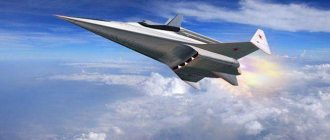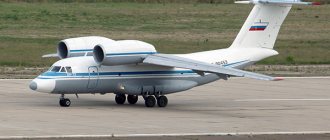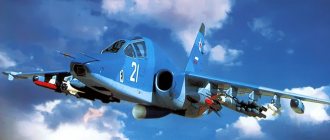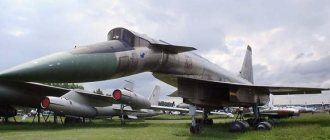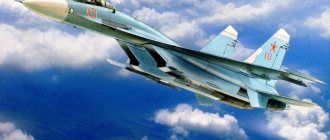The Cold War, which took place between the USA and the USSR in 1946-1991, is long over. At least that's what many experts think. However, the arms race did not stop for a minute, and even today it is in the stage of active development. Despite the fact that today the main threats to the country are terrorist groups, relations between world powers are also tense. All this creates conditions for the development of military technologies, one of which is a hypersonic aircraft.
Necessity
Relations between the United States and Russia are greatly strained. And although at the official level the United States in Russia is called a partner country, many political and military experts argue that there is an unspoken war between the countries not only on the political front, but also on the military one in the form of an arms race. In addition, the United States is actively using NATO to encircle Russia with its missile defense systems.
This cannot but worry the leadership of Russia, which has long ago begun developing unmanned aerial vehicles that exceed hypersonic speed. These drones can be equipped with a nuclear warhead, and they can easily deliver a bomb to anywhere in the world, and quite quickly. A similar hypersonic aircraft has already been created - this is the Yu-71 airliner, which is currently being tested in strict secrecy.
Development of hypersonic weapons
For the first time, testing aircraft that could fly at the speed of sound began in the 50s of the 20th century. Then it was still associated with the so-called Cold War, when two developed powers (USSR and the USA) sought to overtake each other in the arms race. The first project was the Spiral system, which was a compact orbital aircraft. It was supposed to compete with and even surpass the US hypersonic aircraft X-20 Dyna Soar. Also, the Soviet aircraft had to be able to reach speeds of up to 7000 km/h and not fall apart in the atmosphere under overloads.
And although Soviet scientists and designers tried to bring such an idea to life, they failed to even come close to the cherished characteristics. The prototype did not even take off, but the USSR government breathed a sigh of relief when the American plane also failed during testing. The technologies of that time, including in the aviation industry, were infinitely far from the current ones, so the creation of an aircraft that could exceed the speed of sound several times was doomed to failure.
However, in 1991, a test was carried out of an aircraft that could reach speeds exceeding the speed of sound. It was a flying laboratory "Cold", created on the basis of the 5B28 rocket. The test was successful, and then the plane was able to reach a speed of 1900 km/h. Despite progress, development was stopped after 1998 due to the economic crisis.
Hypersonic cruise missiles: Russia is close to success, unknown about the USA
Another important area in hypersonic weapons is cruise missiles. They can be of different types - anti-ship, aviation, etc.
As for the United States, the country has some developments in this area. Attention is worth paying attention to two projects. The first was the X-43A. This experimental cruise missile developed a huge speed of 9.65 Mach (1 Mach = 1 speed of sound) at an altitude of about 30 kilometers. However, the rocket engine only ran for about 10 seconds, so the product was purely a test bed. $230 million was allocated for the work. The second project is the X-51 WaveRider - a prototype of a hypersonic cruise missile, closer to a real combat model. A total of 4 test launches of the rocket were carried out, video footage from the last of them was made public. In its last test in 2013, the X-51 flew 426 kilometers, reaching a speed of 5.1M (6,100 km/h) at an altitude of about 18 kilometers. The creation of this prototype cruise missile demonstrated that the United States had acquired the technology to ensure stable hypersonic flight over sufficiently long distances. However, the X-51 did not have any guidance system and was not intended to carry out strikes - the missile was a “flying laboratory” for testing technologies. Over the course of 8 years, $300 million was allocated from the military budget for WaveRider. Thus, $520 million was invested in two research projects.
There is no other information on American missile projects, so it is not yet possible to judge how close the United States is to creating a real combat hypersonic cruise missile. It is worth noting that the most difficult technical challenge is precisely targeting the target at such high speeds - the plasma cloud disrupts the operation of the instruments and screens the signals of the same GPS navigation satellites. The American prototypes have not even tried to solve this problem yet.
In Russia, work on hypersonic cruise missiles is in full swing. Apparently, the Zircon anti-ship missile (ASM) came closest to a production model. According to various estimates, it will reach speeds of up to 5-6M (6-7 thousand km/h), hitting targets at a range of up to 400 kilometers. Not long ago it was announced that Russian heavy cruisers of Project 1144 Orlan could receive these weapons by 2022. This is quite consistent with the dates given by KTRV General Director Boris Obnosov (this company is involved in all hypersonic missile projects of the Russian Federation) - according to him, the appearance of hypersonic weapons in the arsenal of the Russian army is expected by the early 2020s.
How much such an anti-ship missile system will cost is, again, very difficult to estimate. For example, the Russian export supersonic anti-ship missile P-800 Yakhont costs approximately $5-6 million. For the Russian army the price tag will be approximately 2 times lower. It is logical to assume that the Zircon, even taking into account its superiority over its predecessors, will not be purchased if its price exceeds $10 million per missile (even this cost is very high).
Another project, which is generally at the final stage of testing, is the Kh-32 aviation cruise missile. It will be capable of reaching a speed of 4-5 Mach - this can be considered the threshold for hypersound. Most of the rocket's flight takes place at an altitude of 40 kilometers (there is less air resistance, and therefore heating), after which it dives towards its target. The maximum launch range is estimated at 1000 kilometers. The adoption of the Kh-32 into service will significantly increase the capabilities of the Tu-22M3M long-range bombers (they are the main carrier of this missile). The economic component of this project roughly corresponds to that of Zircon. It is quite possible that work is underway on other projects, but there is no information on them yet.
Technologies of the 21st century
There is no accurate and official information about the development of hypersonic aircraft. However, if we collect materials from open sources, we can conclude that such developments were carried out in several directions at once:
- Creation of warheads for intercontinental ballistic missiles. Their mass exceeded the mass of standard missiles, but due to the ability to maneuver in the atmosphere, it is impossible or, at least, extremely difficult to intercept them with missile defense systems.
- The development of the Zircon complex is another direction in the development of technology, which is based on the use of the Yakhont supersonic missile defense system.
- Creation of a complex whose rockets can exceed the speed of sound 13 times.
If all these projects are united in one holding company, then by joint efforts an air-, ground- or ship-based missile can be created. If the Prompt Global Strike project, created in the United States, is successful, then the Americans will have the opportunity to hit anywhere in the world within one hour. Russia will be able to defend itself only with technologies of its own development.
American and British experts have recorded tests of supersonic missiles that can reach speeds of up to 11,200 km/h. Given such a high speed, it is almost impossible to shoot them down (not a single missile defense system in the world is capable of this). Moreover, they are even extremely difficult to spy on. There is very little information about the project, which sometimes appears under the name "Yu-71".
History of hypersonic vehicles
Hypersound is far from a new direction in the development of offensive weapons. The creation of aircraft with speeds several times higher than the speed of sound (more than Mach 5) began in Nazi Germany, at the very beginning of the rocket era. These works received a powerful impetus after the beginning of the nuclear age and went in several directions.
Various countries have sought to create devices capable of developing hypersonic speeds; there have been attempts to create hypersonic cruise missiles, as well as suborbital aircraft. Most of these projects ended without results.
In the 60s of the last century, the United States began developing a project for the North American X-15 hypersonic aircraft, which could make suborbital flights. Thirteen of his flights were classified as suborbital, their altitude exceeding 80 kilometers.
In the Soviet Union there was a similar project called “Spiral”, which, however, was never brought to life. According to the plan of Soviet designers, the booster jet was supposed to reach hypersonic speed (6 M), and then a suborbital vehicle equipped with rocket engines would take off from its back. This device was planned to be used mainly for military purposes.
Work in this direction is also being carried out today by private companies that plan to use similar devices for suborbital tourism. However, these developments are already taking place at the current level of technology development and, most likely, will end successfully. Today, to ensure high speed of such devices, ramjet engines are often used, which will make the use of such aircraft or drones relatively cheap.
The creation of cruise missiles with hypersonic speed is also moving in the same direction. In the United States, the government program Global Prompt Strike (quick or lightning-fast global strike) is being developed, which is aimed at gaining the ability to deliver a powerful non-nuclear strike on any point on the planet within one hour. As part of this program, new hypersonic vehicles are being developed that can both carry a nuclear charge and do without it. As part of the Global Prompt Strike, several projects of cruise missiles with hypersonic speed are being promoted, but the Americans cannot yet boast of serious achievements in this direction.
Similar projects are being developed in Russia. The fastest cruise missile to enter service is the Brahmos anti-ship missile, developed jointly with India.
If we talk about spacecraft that develop hypersonic speed, we should remember reusable spacecraft, which during descent develop a speed many times greater than the speed of sound. Such ships include the American shuttles and the Soviet Buran, but their time has most likely passed.
If we are talking about unmanned hypersonic aerial vehicles, then we should note hypersonic warheads, which are the warhead of ballistic missile systems. Essentially, these are warheads capable of maneuvering at hypersonic speeds. They are also often called gliders for their ability to plan. Today, three countries are known to be working on similar projects: Russia, the USA and China. It is believed that China is the leader in this direction.
The American hypersonic warhead AHW (Advanced Hypersonic Weapon) passed two tests: the first was successful (2011), and during the second the rocket exploded. According to some sources, the AHW glider can reach speeds of up to Mach 8. The development of this device is carried out within the framework of the Global Prompt Strike program.
In 2014, China conducted the first successful tests of the new hypersonic glider WU-14. There is evidence that this warhead can reach a speed of about Mach 10. It can be installed on various types of Chinese ballistic missiles, in addition, there is information that Beijing is actively working on creating its own hypersonic ramjet engine, which can be used to create vehicles launched from aircraft.
The Russian response to the developments of strategic competitors should be the Yu-71 (Project 4202), which was tested at the beginning of this year.
What is known about the Russian hypersonic aircraft Yu-71?
Considering that the project is classified, there is very little information about it. It is known that this glider is part of a supersonic rocket program, and in theory it is capable of flying to New York in 40 minutes. Of course, this information has no official confirmation and exists at the level of guesswork and rumors. But given that Russian supersonic missiles can reach speeds of 11,200 km/h, such conclusions seem quite logical.
According to various sources, the hypersonic aircraft “Yu-71”:
- Has high maneuverability.
- Can plan.
- Capable of reaching speeds of over 11,000 km/h.
- Can go into space during a flight.
The most famous facts about Russia's secret weapon Yu-71
The secret Yu-71 glider, which is part of Russia's supersonic missile program, is capable of flying to New York in 40 minutes. Although this information has not been officially confirmed, based on the fact that supersonic Russian missiles are capable of reaching speeds of over 11,00 km/h, exactly the same conclusions can be drawn.
According to the little information that can be found about it, the Yu-71 glider is capable of:
- Fly at speeds over 11,000 km/h;
- Has incredible maneuverability;
- Able to plan;
- During the flight it can go into space.
Although the tests have not yet been completed, everything suggests that by 2025, Russia may have this supersonic glider armed with nuclear warheads. Such a weapon will be capable of reaching almost anywhere in the world within an hour and delivering a targeted nuclear strike.
Dmitry Rogozin said that the Russian defense industry, which was the most developed and advanced during the Soviet era, fell far behind in the arms race during the 90s and 2000s. Over the past decade, the Russian army has begun to revive. Soviet technology is being replaced by modern high-tech models, and fifth-generation weapons, which have been “stuck” in design bureaus in the form of projects on paper since the 90s, are beginning to take on very specific shapes. According to Rogozin, new Russian weapons may surprise the world with their unpredictability. By unpredictable weapon, they most likely meant the Yu-71 glider, armed with nuclear warheads.
Although this device has been in development since at least 2010, information about its tests reached the US military only in 2015. The Pentagon fell into complete despondency because of this, because if the Yu-71 is used, the entire missile defense system, which is installed along the perimeter of Russian territory, becomes absolutely useless. In addition, the United States of America itself becomes defenseless against this secret nuclear glider.
The Yu-71 is capable of not only delivering nuclear strikes against the enemy. Thanks to the presence of a powerful, ultra-modern electronic warfare system, the glider is capable of disabling all detection stations equipped with electronic equipment in a few minutes while flying over US territory.
If you believe NATO reports, then from 2022 to 2025, up to 24 Yu-71 type devices may appear in the Russian army, any of which is capable of crossing the enemy border undetected and destroying an entire city with a few shots.
Statements
At the moment, tests of the Russian hypersonic aircraft Yu-71 have not yet been completed. However, some experts argue that by 2025 Russia may receive this supersonic glider, and it could be equipped with nuclear weapons. Such an aircraft will be put into service, and in theory it will be capable of delivering a targeted nuclear strike anywhere on the planet within just one hour.
Russia's representative to NATO, Dmitry Rogozin, said the USSR's once most developed and advanced industry had fallen behind the arms race in recent decades. However, more recently the army has begun to revive. Outdated Soviet technology is being replaced by new models of Russian developments. In addition, fifth-generation weapons, stuck in the 90s in the form of projects on papers, are taking on visible shape. According to the politician, new models of Russian weapons may surprise the world with their unpredictability. It is likely that Rogozin is referring to the new hypersonic aircraft Yu-71, which can carry a nuclear warhead.
It is believed that the development of this aircraft began in 2010, but the United States learned about it only in 2015. If the information about its technical characteristics is true, then the Pentagon will have to solve a difficult problem, since the missile defense systems used in Europe and on its territory will not be able to provide counteraction to such an aircraft. In addition, the United States and many other countries will simply be defenseless against such weapons.
Yu-71: what is known today
In mid-2022, an article in the American publication The Washington Free Beacon caused a great stir. According to journalists, in February 2022, Russia tested a new hypersonic aircraft, the Yu-71, for military purposes. The material reported that the Russian device can reach speeds of up to 11 thousand km/h, and also maneuver along the descent trajectory. Such characteristics make it virtually invulnerable to any modern missile defense systems.
Yu-71 is also called a glider. It was launched in low-Earth orbit, and was delivered there by the SS-19 Stiletto intercontinental ballistic missile (UR-100 N). It launched from the area of deployment of the Dombarovsky Strategic Missile Forces formation. According to the same publication, it is this military unit that will be armed with similar glider combat units until 2025.
Experts believe that the Yu-71 is part of the top-secret Russian Project 4202, related to the development of new strategic weapons, which started in 2009. There is very little information about the new warhead (which is quite understandable), only the speed and ability to maneuver at the final stage of the trajectory are mentioned. However, even with such characteristics, the Yu-71 is no longer afraid of any missile defense systems of our day.
The Russian General Staff stated back in 2004 that they had tested an aircraft capable of developing hypersonic speeds, while performing maneuvers both in altitude and heading. This coincides with the launch of the UR-100N UTTH ICBM from the Baikonur test site against a target at the Kura test site.
In 2011, information appeared about the test launch of a ballistic missile with special equipment capable of overcoming modern and promising missile defense systems. Probably, one of the promising Russian ballistic missiles will be equipped with a new warhead, most often called the new Sarmat missile (RS-28 ICBM).
The fact is that such warheads have a relatively large mass, so it is better to install them on powerful carriers capable of carrying several Yu-71s at once.
According to scant information from Russian sources, the development of Project 4202 is being carried out by NPO Mashinostroeniya in the town of Reutov near Moscow. In addition, the press reported on the technical re-equipment of the Strela Production Association (Orenburg), undertaken with the aim of participating in the 4202 project.
The warheads of modern ballistic missiles develop hypersonic speeds during their descent trajectory and are capable of performing quite complex maneuvers. Experts consider the main difference between the Yu-71 to be an even more difficult flight, comparable to the flight of an airplane.
In any case, the adoption of such units into service will significantly increase the effectiveness of the Russian Strategic Missile Forces.
There is information about the active development of hypersonic cruise missiles, which could become a new weapon for Russian combat aircraft, in particular the promising PAK DA strategic bomber. Such missiles represent a very difficult target for interceptor missiles of missile defense systems.
Such projects could render the missile defense system as a whole useless. The fact is that objects flying at high speed are extremely difficult to intercept. To do this, interceptor missiles must have high speed and the ability to maneuver with huge overloads, and such missiles do not yet exist. It is very difficult to calculate the trajectories of maneuvering warheads.
Development plans
Of course, there is no data regarding the adoption of the promising Yu-71 aircraft, but it is known that it has been in development since 2009. In this case, the device will be able not only to fly in a straight path, but also to maneuver.
It is maneuverability at hypersonic speeds that will become a feature of the aircraft. Doctor of Military Sciences Konstantin Sivkov argues that intercontinental missiles can reach supersonic speeds, but at the same time they act like conventional ballistic warheads. Consequently, their flight path is easily calculated, which makes it possible for the missile defense system to shoot them down. But controlled aircraft pose a serious threat to the enemy, since their trajectory is unpredictable. Consequently, it is impossible to determine at what point the bomb will be released, and since the release point cannot be determined, the trajectory of the warhead’s fall is not calculated.
In Tula on September 19, 2012, at a meeting of the military-industrial commission, Dmitry Rogozin said that a new holding should soon be created, the task of which would be to develop hypersonic technologies. The enterprises that will be part of the holding were immediately named:
- "Tactical missile weapons."
- "NPO Mashinostroyenia" At the moment, the company is developing supersonic technologies, but at the moment the company is part of the Roscosmos structure.
- The next member of the holding should be the Almaz-Antey concern, which is currently developing technologies for the aerospace and missile defense industries.
Rogozin believes that such a merger is necessary, but legal aspects do not allow it to take place. It is also noted that the creation of a holding does not imply the absorption of one company by another. This is precisely the merger and joint work of all enterprises, which will speed up the development of hypersonic technologies.
Chairman of the Council under the Russian Ministry of Defense Igor Korotchenko also supports the idea of creating a holding company that would develop hypersonic technologies. According to him, the new holding is really necessary, because it will allow all efforts to be directed to the creation of a promising type of weapon. Both companies have great potential, but individually they will not be able to achieve the results that are possible by combining their efforts. It is together that they will be able to contribute to the development of the Russian defense complex and create the fastest aircraft in the world, the speed of which will exceed expectations.
Weapons as a tool of political struggle
If by 2025 not only hypersonic missiles with nuclear warheads are in service, but also Yu-71 gliders, this will seriously strengthen Russia’s political position in negotiations with the United States. And this is completely logical, because all countries during negotiations act from a position of strength, dictating favorable conditions to the opposite side. Equal negotiations between the two countries are possible only if both sides have powerful weapons.
Vladimir Putin, during a speech at the Army 2015 conference, said that nuclear forces are receiving 40 new intercontinental missiles. These turned out to be hypersonic missiles, and they can currently overcome existing missile defense systems. Viktor Murakhovsky, a member of the expert council of the military-industrial commission, confirms that ICBMs are being improved every year.
Russia is also testing and developing new cruise missiles that can fly at hypersonic speeds. They can approach targets at ultra-low altitudes, making them virtually invisible to radar. Moreover, modern missile defense systems in service with NATO cannot hit such missiles due to their low flight altitude. In addition, in theory, they are capable of intercepting targets moving at speeds of up to 800 meters per second, and the speed of the Yu-71 aircraft and cruise missiles is much higher. This makes NATO missile defense systems almost useless.
Hypersonic glider Yu-74: Russia has developed a US missile defense killer
Successful tests of the experimental Russian glider Yu-74, launched using an intercontinental ballistic missile RS-18A Stiletto (UR-100N) from the Dombarovsky training ground near Orenburg against a target at the Kura training ground in Kamchatka, caused extreme concern among the command of the US armed forces. Although the details of the test have not been disclosed, what is known for now is that it was a complete success, the scale of which overturns the entire US missile defense system.
This is confirmed by the urgent adoption by the Armed Services Committee of the US Congress of an amendment to the National Defense Appropriations Bill, which provides for the allocation of additional funds to the US Missile Defense Agency to develop a program to combat the finally emerging threat of high-speed maneuvering missiles.
Currently, the US missile defense system is based on a three-layered set of countermeasures. The first, farthest line of interception is considered to be the middle section of the trajectory of an attacking ballistic missile after it enters outer space at the end of acceleration. The National Missile Defense (NMD) complex is designed to hit targets at long range in the United States. It consists of three fixed PAVE PAWS radar systems (located at Cape Cod in Massachusetts, Beal in California and Clear in Alaska) and two GBI (Ground-Based Interceptor) missile silo launcher sites at Fort Greely, USA. Alaska (26 missiles deployed there to date) and Vanderburgh, California (4 missiles deployed in 2013, with plans to increase to 14 by 2022). After the successful launch of the North Korean Unha-3 missile in December 2012, the US Missile Defense Agency began selecting a site for a third positioning area. Those considered as such are Fort Drum (New York), Training Camp Ethan Allen (Vermont), SERE Naval Air Station (Maine), Ravenna Training Center (Ohio) and Fort Custer (Michigan).
PAVE PAWS radars provide an almost continuous field of view around the United States, with the exception of the “corridor” passing through the Gulf of Mexico and Central America. Their range of action reaches 2000 km, which was considered sufficient to identify the threat of a missile attack and guide anti-missile missiles, despite the fact that they are not capable of detecting and tracking targets in the early stages.
The placement of GBI position areas was selected based on information about the direction of approach of Soviet/Russian ballistic missiles, as well as the most likely trajectories of suspected DPRK ballistic missiles. The GBI interceptor missile is designed to hit targets at a distance of 2 to 5.5 thousand km. depending on the interception altitude, the limit of which is 2000 km. The destructive element of the GBI is the EKV kinetic interceptor weighing 64 kg, designed to directly engage a warhead with a ramming strike on a collision course. Theoretically, the GBI system was supposed to provide target interception at any point in space, but in practice it has significant limitations in trajectories and directions. From June 1997 to the present, 39 test launches have been carried out, of which 20 were intended to test the systems and 17 to intercept a training target. Based on the test results, the interception reliability is 47%, which is close to the calculated efficiency of the complex.
In 2002, the NMD complex was combined with other elements of the missile defense system, in particular, with the naval AEGIS system, and renamed Ground-Based Midcourse Defense (GBMD). The purpose of the merger was to increase the integration of long-range interception systems with the mobile system of the THAAD (Terminal High Altitude Area Defense) anti-missile system.
The THAAD system is a mobile battery on an all-terrain wheeled chassis, consisting of three launchers with a total of 24 missiles, a command center and an X-band radar. The cost of one battery is $2.3 billion. THAAD missiles are capable of intercepting targets at an altitude of up to 200 km, i.e. with exit beyond the atmosphere into near space. At the moment, the United States has two such batteries and is forming two more, which are scheduled to enter combat duty in 2022-2022. As of 2014, the current stock of THAAD interceptor missiles is 102 pcs.
Despite the fact that the THAAD complex has been officially adopted for service, its testing program has not yet been completed. According to available data, after the completion of system debugging tests, 12 test interceptions of training targets were carried out, 90% of which were considered successful. However, according to the commission’s conclusion, the THAAD complex as a whole demonstrated high effectiveness only against outdated ballistic missiles of the R-17 type and is inferior in its characteristics even to the Russian S-300 complex, especially its latest modifications. Also controversial is the use of a kinetic principle of destruction, similar to the NMD system. On the one hand, this guarantees the complete destruction of the target, but at the same time it imposes very high requirements for targeting the anti-missile missile and limits its ability to intercept actively maneuvering targets.
The last frontier of missile defense is the batteries of the Patriot short-range air defense system. The assessment of their effectiveness is subjective and is based on the experience of using the Patriot air defense system against the Scud OTR in Iraq in 2003.
Until April 2016, the US military-political leadership considered such a missile defense system to be quite reliable and generally provide the necessary level of repelling a missile threat. Successful tests of the Yu-74 glider showed that Russia has at its disposal maneuvering hypersonic aircraft, which the American missile defense system is not able to successfully intercept.
The Yu-74 glider was developed as part of the 4202 program to create the warheads of the promising Russian strategic ballistic missile Sarmat, which is intended to replace the RS-20 Voevoda missiles in service with the Russian Strategic Missile Forces in 2022-2022. One Sarmat missile will be able to carry up to 24 nuclear-equipped Yu-74 gliders and hit any target at a range of up to 10 thousand km within an hour.
The tactical and technical characteristics of the Yu-74 are secret. Open sources only report that the device is capable of reaching speeds of up to 12M and actively maneuvering in altitude and heading, which even allows maneuvers to bypass areas where missile defense systems are deployed and move in directions and trajectories that make interception as difficult as possible. It is also known that in addition to a nuclear warhead, the glider is capable of carrying additional equipment. Including active and passive electronic warfare equipment, as well as decoy simulators. This ensures a guaranteed breakthrough of any existing and future missile defense system of a potential enemy. The adoption of such units into service by the Russian Strategic Missile Forces significantly increases their effectiveness. There is also information about the project to create air-launched hypersonic cruise missiles in Russia, which in many respects are similar to the combat capabilities of the Yu-74, has reached the final stage.
Until recently, the United States denied the ability of other countries to create effective models of hypersonic aircraft. Especially given the Pentagon's conviction of America's unconditional superiority in the development of advanced high-tech weapons. This position was justified, among other things, by the failures of its own project of the hypersonic warhead AHW (Advanced Hypersonic Weapon), the second launch of which, despite its success in 2011, ended in a rocket explosion. According to sources at DARPA (Defense Advanced Research Projects Agency), the current Global Prompt Strike program, within which the AHW is being created, has not yet been able to solve technical reliability problems, even taking into account the fact that the maximum speed of the AHW does not exceed 8M. The successful test results of the Russian Yu-74 clearly demonstrated the categorical fallacy of the American point of view. In addition, China successfully tested its own hypersonic attack unmanned aerial vehicle WU-14.
As Congressman Trent Franks put it, Russia's and China's advances in hypersonic weapons are fundamentally changing the entire paradigm of modern warfare.
The hypersonic era is coming, in which America no longer has absolute superiority. Bringing it back is the main strategic goal of the United States. The fastest way is to improve the THAAD ground system. “Then we can start developing laser weapons capable of shooting down hypersonic missiles that travel at nine times the speed of sound.” The head of the US Missile Defense Agency, James Syring, confirmed the US government's intention to invest an additional $23 million in the development of laser weapons, in addition to already approved programs. However, testing of the new laser air defense/missile defense system should be expected no earlier than 2022. Send by email
Projects from other countries
It is known that China and the United States are also developing an analogue of the Russian hypersonic aircraft. The characteristics of the enemy models are still unclear, but we can already assume that the Chinese development is capable of competing with the Russian aircraft.
Known as the Wu-14, the Chinese aircraft was tested in 2012, and even then it was able to reach speeds of over 11,000 km/h. However, there is no mention anywhere about the weapons that this device is capable of carrying.
As for the American Falcon HTV-2 drone, it was tested several years ago, but 10 minutes into the flight it crashed. However, before it, the X-43A hypersonic aircraft was tested, which was carried out by NASA engineers. During tests, it showed a fantastic speed of 11,200 km/h, which is 9.6 times the speed of sound. The prototype was tested in 2001, but then during the tests it was destroyed due to the fact that it got out of control. But in 2004 the device was successfully tested.
Similar tests by Russia, China and the United States cast doubt on the effectiveness of modern missile defense systems. The introduction of hypersonic technologies in the military-industrial sector is already producing a real revolution in the military world.
